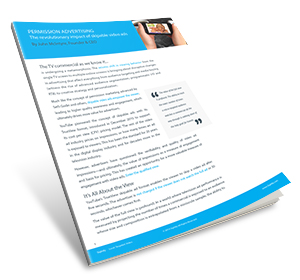The commercial as we know it is undergoing a metamorphosis. The seismic shift in viewing behavior from the single TV screen to multiple online screens is bringing about disruptive changes in advertising that affect everything from audience targeting and media buying (witness the rise of advanced audience segmentation, programmatic buying and real-time bidding) to creative strategy and personalization.
One technology overlooked in today’s collective ad tech conversation is the skippable video ad. Much like the concept of permission marketing advanced by Seth Godin and others, skippable video ads empower the viewer, leading to higher quality awareness and engagement, which ultimately drives more value for advertisers.
 YouTube pioneered the concept of skippable ads with its TrueView format, introduced in December 2010, to support its cost per view (CPV) pricing model. The rest of the video ad industry sets its prices based on impressions, or how many times an ad is exposed to viewers. This has been the standard for 20 years in the digital display industry and for decades more in the television industry.
YouTube pioneered the concept of skippable ads with its TrueView format, introduced in December 2010, to support its cost per view (CPV) pricing model. The rest of the video ad industry sets its prices based on impressions, or how many times an ad is exposed to viewers. This has been the standard for 20 years in the digital display industry and for decades more in the television industry.
However, advertisers have questioned the verifiability and quality of video ad impressions—and ultimately, the value of impressions as a measure of engagement and basis for pricing. This has created an opportunity for a more valuable measure of engagement with video ads. Enter the qualified view.
It's All About the View
YouTube's TrueView skippable ad format enables the viewer to skip a video ad after five seconds. The advertiser is not charged if the viewer does not watch the full ad, or 30 seconds, whichever comes first.
The value of the full view is profound. In a  world where television ad performance is measured by projecting the number of times a commercial is exposed to an audience whose size and composition is extrapolated from a miniscule sample, the ability to track the exact number of times a micro-targeted audience watches a commercial all the way through is nothing short of the holy grail for brands.
world where television ad performance is measured by projecting the number of times a commercial is exposed to an audience whose size and composition is extrapolated from a miniscule sample, the ability to track the exact number of times a micro-targeted audience watches a commercial all the way through is nothing short of the holy grail for brands.
A viewer who chooses to watch a full video ad is a highly qualified viewer. Research shows that a viewer who decides to watch a skippable video ad is 75% more engaged than a viewer forced to watch a standard non-skippable ad. That viewer may be in-market already or the ad may itself trigger the viewer's intent to purchase and establish strong consideration for the advertiser's brand.
Anecdotally, we've seen these highly-qualified views dramatically drive up natural brand search activity—from 60 to 300% locally—during video ad campaigns run for clients on YouTube.
But Wait, There's More
Even viewers who opt to skip an ad watch part of it. And because the technology allows us to measure exactly how many of them watch how much of the ad, we can assign specific added value to those partial views based on the cost per full view.
Remember, in YouTube's model, the advertiser doesn't pay for partial views unless they occur beyond the 30-second mark of an ad. Indeed, these partial views represent what has always eluded advertisers who strove to assign real value to impressions:
Partial Views = Qualified Brand Impressions
Here's a real world example. A recent four-week video ad campaign for a national brand delivered 218,142 full views at an average cost of $0.14 per view. However, it also delivered the following partial views:
- 91,165 watched between 75% and 99% of the ad
- 89,652 watched between 50% and 74% of the ad
- 244,050 watched between 25% and 49% of the ad and
- 184,111 watched at least 5 seconds, but less than 25% of the ad
Using the $0.14 cost per full view as a basis, we determined a value for these 609,000 partial views of $29,545.
Advertisers receive added value like this in every skippable video ad campaign.
 While we presume that ad views both partial and full measurably contribute to brand awareness and familiarity, we have also seen impact in middle to bottom of the funnel activity where viewers engage with the brand during the evaluation phase closing toward purchase. In this brand's case, the lift was a 162% increase in brand searches during the four weeks of the video ad campaign.
While we presume that ad views both partial and full measurably contribute to brand awareness and familiarity, we have also seen impact in middle to bottom of the funnel activity where viewers engage with the brand during the evaluation phase closing toward purchase. In this brand's case, the lift was a 162% increase in brand searches during the four weeks of the video ad campaign.
Video ad views produce lift for other elements in the advertising and marketing mix as well. E.g., comScore recently reported, “Supplementing TV campaigns with digital channels has shown to extend the reach by as much as 12 incremental percentage points.”2 Anecdotally, we’ve seen natural Google search activity for brands or products increase 15% to as much as 300% during and following video ad campaigns. And conversions from paid search campaigns have shown to increase from 50% to 150%.
The Rewards of Permission Advertising
Video ads are inherently interruptive—except when viewers are receptive to them. Then viewers perceive them as interesting, informative, even entertaining.
So it follows logically that engagement is higher among those viewers who choose to watch skippable ads through to completion. If you’re shown a non-skippable ad that has no current relevance for you, you’re more likely ignore it or do something else while it plays.
The rewards of permission advertising go beyond the economics of paying only for full views. By enabling viewers to skip their video ads, advertisers:
- Highly qualify and engage viewers,
- Establish real added value for partial views as “qualified brand impressions,” and
- Drive customer engagement through clicks and other in-market actions such as brand name local searches.
Skippable ads provide a final layer of audience targeting for video campaigns and as such, should be the default format for every online advertiser interested in achieving the best performance for the greatest value.
 Click the button to get a portable copy of this brief and all the details of the four-week brand national campaign case study that reveal:
Click the button to get a portable copy of this brief and all the details of the four-week brand national campaign case study that reveal:
- How skippable video ads delivered more value in partial views than the client spent on full views
- The "multiplier effect" video advertising has on other elements of the marketing/ad mix, especially search and even TV…and more!
A version of this original Sightly article first appeared in MediaPost's Online Video Insider on May 23, 2014.

